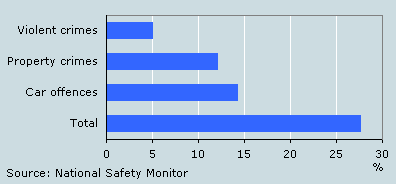Young people and city-dwellers frequent victims of crime

In 2006, over one quarter of people in the age group 15 years and older reported they had been victims of common crime. Proportionally, many of the victims were young and living in neighbourhoods with a high urbanisation rate.
One in eight victim of property crime
Approximately 5 percent were victims of violent crime (physical abuse, threatening behaviour, sexual harassment) and 12 percent were victims of property crimes (burglary or attempted burglary, bicycle theft, robbery); 14 percent of motorists fell victim to car theft or had their car broken into or damaged.
Victims of common crime

Young people twice as often victims of crime as older people
Young people are more frequent victims of crime than older people. In the 15-24 age bracket, the rate was more than four in ten, as against two in ten among persons aged 45 and older. Male victims of crime (29 percent) slightly outnumber their female counterparts (26 percent).
One in three victims live in densely populated neighbourhoods
Residents of highly urbanised municipal districts are more frequent crime victims (one in three) than those living in neighbourhoods with a low degree of urbanisation (nearly one in four). The crime rate is also higher when the composition of the population is changing permanently because many people move in and out of the neighbourhood.
Victims of common crime by various characteristics

Differences manifest in all types of crime
Victims of common crime are mostly young. This applies to all types of crimes, but in particular to violent and property crimes. The differences are smaller for car offences.
People living in densely populated neighbourhoods also more often fall victim to violent crimes, property crimes and car offences than residents living in a less urbanised environment.
Victims by type of offence, 2006

Harry Huys